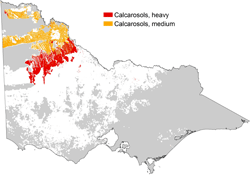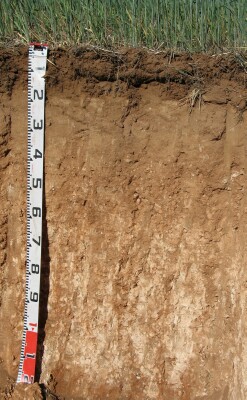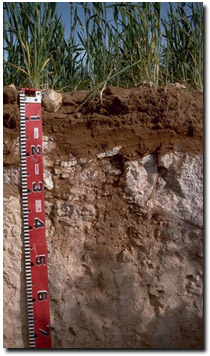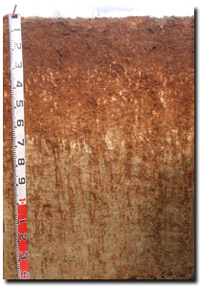Victorian Grain Cropping Soils - Calcarosols
Back to: Soils of Victorian Grain Cropping Regions
Calcarosols (often called ‘mallee loams’,‘mallee sands’ or ‘calcareous earths’) are formed on calcareous aeolian (wind-blown) sediments. They generally have a small, gradual increase in clay content with depth (i.e. there is not a strong texture contrast between surface soil and subsoil as compared to Sodosols). They are calcareous throughout and usually have visible accumulations of calcium carbonate (lime) in the soil profile, either in soft form, nodules or as hard blocks. The soil profile is typically alkaline throughout and sodicity and salt levels can be high in the deeper subsoils.
Distribution
| Calcarosols are widespread soils in the Mallee and Wimmera grain cropping regions of Victoria. They vary quite considerably in terms of soil texture in the upper part of the soil profile - ranging from those dominated by sands to those that are clayey throughout. Three textural types are shown on the map: medium textured, heavy textured (as described below) as well as Calcareous sands that are described separately in the Sandy soils section. |  |
Medium textured Calcarosols
| Medium-textured Calcarosols predominate in the central and northern Mallee region where east-west dunes alternate with broad swales. The soils in the swales (between dunes) and broad north-south trending ridges generally have sand to sandy loam surface soils overlying clay loam to light clay subsoils that are often sodic. Soil pit site LWA2 is an example of a medium-textured Calcarosol near Chinkapook. Calcareous Sands are most common on the east-west dunes themselves and are typically sandy throughout, or at least in the upper 50 cm of the soil profile. |  Medium-textured Calcarosol near Chinkapook |
| In some areas of the Mallee, Calcarosols can be quite shallow, overlying a solid limestone layer that can be a metre or more in thickness. They are not mapped separately here but predominate in the western Mallee between Murrayville and Underbool where their occurrence is discontinuous. On cultivated soils, a litter of limestone blocks will often occur, that reduces wind erosion but will cause wear and tear on machinery. Water holding capacity is reduced by the stone content as well as the shallow soil depth. Soil pit MP17 is an example of a medium-textured Calcarosol that is dominated by hard limestone layers in the subsoil. |  Shallow medium-textured Calcarosol at Walpeup |
Heavy-textured Calcarosols
| Heavy-textured Calcarosols are common on lower slopes and plains in the southern Mallee and northern Wimmera regions where east-west dunes are less frequent or replaced by rounded hummocks. They typically have a clay loam to light clay surface and the clay increases gradually with depth further down the soil profile. Heavy-textured Calcarosols can often be gilgaied on the plains and ridge slopes. In some areas, they may grade into Vertosols. Soil pit site ORZC13 is an example of a heavy-textured Calcarosol near Birchip (clay loam surface). |  Heavy-textured Calcarosol near Birchip |
Management Considerations
General
Soil texture has a big influence on agronomic performance. Sands are easily worked, but they have lower fertility reserves, compared to other Calcarosols, and are very prone to wind erosion. Heavier-textured Calcarosols are more fertile and less erodible, but can be more prone to salting (particularly in lower parts of the landscape) and structural decline when over-cultivated.
Whole Profile
Management strategies for all soils should include: increasing organic matter levels in the surface soil, minimising the degradation of soil aggregates and porosity, promoting the development of stable biopores, improving the calcium status of the cation exchange complex (particularly when sodium is a significant part) and breaking up any hardpans. Less frequent tillage, using less aggressive implements and working the soil at its optimum moisture content, can all assist in maintaining soil aggregation and porosity, as well as reducing organic matter breakdown. Maintaining adequate surface cover (e.g. stubble) to prevent erosion is important.
For most Calcarosols the soil profile is strongly to extremely alkaline throughout. This indicates that phosphorus and trace elements such as iron, manganese, copper and zinc may be poorly available to plants. In some areas, the immediate surface horizon may be neutral to slightly alkaline, but alkalinity will increase significantly at depth.
Surface (A) Horizons
Tillage of heavier-textured Calcarosols should be avoided if the soil is wet (i.e. wetter than the plastic limit). At such moisture conditions excessive tillage, trafficking or over-stocking could result in some structural damage (e.g. compaction). Ideally, tillage on clayey soils should take place when the soil is drier than the plastic limit – down to at least the depth of tillage.
The surface soil can be sodic and dispersive after remoulding. This indicates that structural degradation (e.g. surface sealing, crusting, increased cloddiness) may occur if the soil is cultivated or overstocked in a moist to wet condition. Also, raindrop action on bare surface soil may also promote dispersion and result in surface sealing or surface crust formation. Surface cover should be maintained to protect against raindrop damage. The use of gypsum may also assist in ameliorating the surface soil. Management practices such as minimum tillage, stubble retention and pasture rotation can be used to improve organic matter levels.
The surface soil of many Calcarosols is often well suited as a seedbed – as the surface condition can be soft and has a weak consistence (i.e. it does not become excessively hard). They are often quite shallow and should be protected as much as possible from wind and water erosion as well as over-cultivation. Promoting organic matter levels and maintaining surface cover will be beneficial. Increasing organic matter levels assist in improving surface soil aggregation and ameliorating hardsetting conditions. Organic matter levels will decline under cropping, but can be improved by adopting practices such as minimum tillage, residue retention, and utilising pasture rotations.
Hardsetting surface horizons that disperse in water (particularly after remoulding) can occur, particularly on heavier-textured surface horizons. This indicates that dispersion may occur if the soil is tilled in a moist to wet condition. Also, raindrop action on bare surface soil may also promote dispersion and result in surface sealing or surface crust formation. Surface cover should be maintained as much as possible to protect against raindrop damage. The use of gypsum may also assist in ameliorating surface soil condition if dispersion occurs.
Sandy surface horizons will have rapid water infiltration, slowing down at the less permeable calcrete substrate. Water holding capacity is lower in the sandier surface horizons and young plants require more frequent showers to survive. However, the low wilting point value indicates that plants will be able to utilise light rains during dry periods by immediately taking up water. It is important to maintain surface cover as sandy surface soils are most prone to wind erosion.
Subsoil (B) Horizons
Subsoils are often sodic and dispersive. This is likely to result in restricted root and water movement into the subsoil.
Boron levels can often be quite high in the subsoil which can affect the growth of boron-sensitive species (including cereals, pulses, pasture legumes) where concentrations as low as 10 ppm, for example, can reduce lentil yield. Limited data estimates that the threshold level of soluble boron for cereals is 15 mg/kg (Cartwright et al., 1984). Other work indicates that where there are low levels of soluble salts, boron tolerance can be comparatively high, with little reduction in wheat yield at levels of up to 45 ppm (Quinlan, 2001).
The level of soluble salts can also be high in the subsoil, which will restrict the growth of salt-sensitive species. Excessive soil salinity can affect the plant's ability to take up water and can also have a toxic effect on plants.
References:
Cartwright, B., Zarcinas, B.A, and Mayfield, A.H. (1984). Toxic Concentrations of Boron in a Red-Brown Earth at Gladstone, South Australia. Australian Journal of Soil Research. 22. 261-72.
Quinlan, J. (2001). Sorting out the Boron Problem. Wimmera Farming & Landcare Newsletter. 19-20.
Rengasamy, P. and Churchman, G.J. (1999). Cation Exchange Capacity, Exchangeable Cations and Sodicity. In: Soil Analysis – An Interpretation Manual. (eds. Peverill, K.I et al). CSIRO Publishing.


